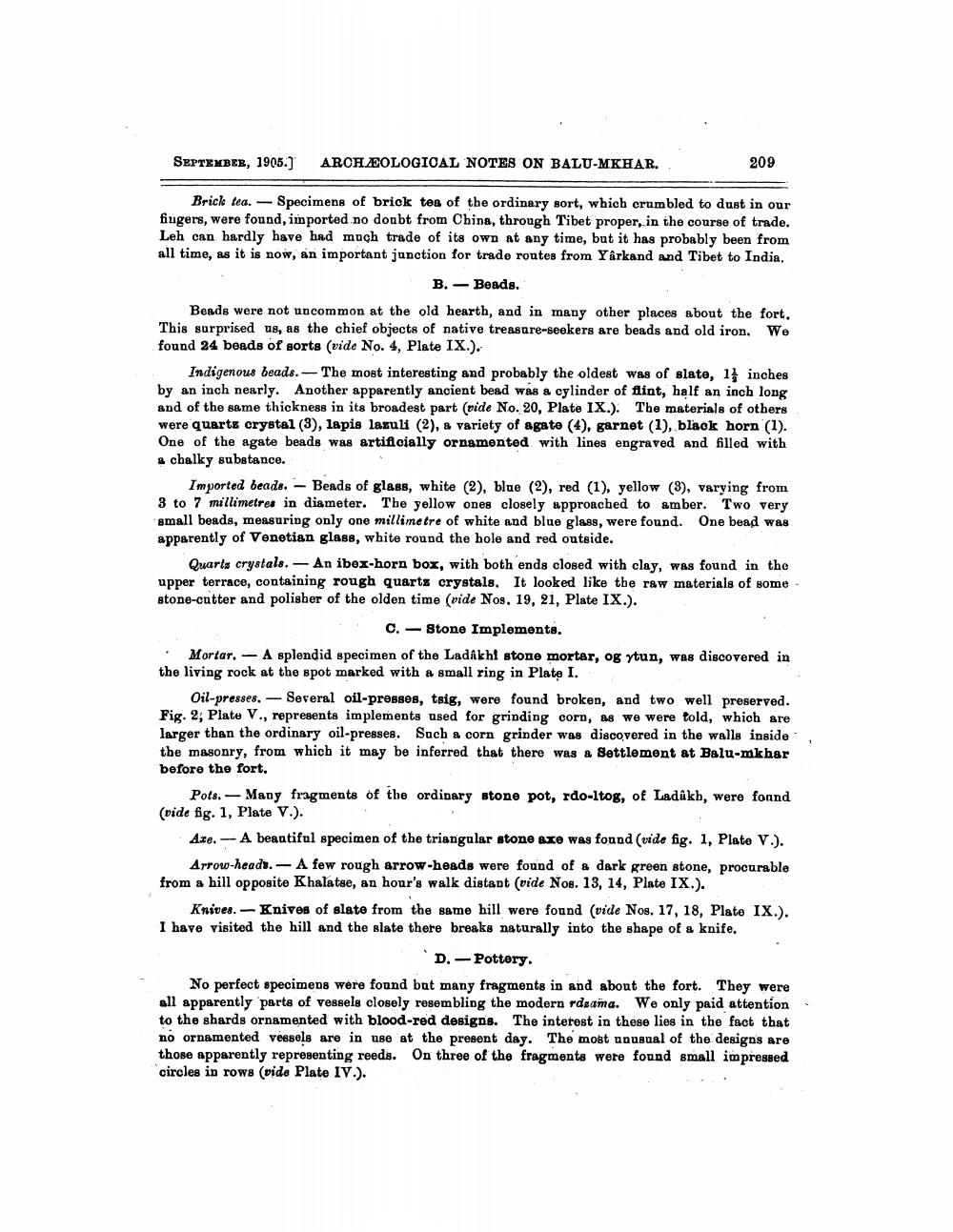________________
SEPTEMBER, 1905.)
ARCHÆOLOGICAL NOTES ON BALU-MKHAR.
209
Brick tea. - Specimens of brick tes of the ordinary sort, which crumbled to dust in our fiugers, were found, imported no doubt from China, through Tibet proper, in the course of trade. Leh can hardly have had much trade of its own at any time, but it has probably been from all time, as it is now, an important junction for trade routes from Yârkand and Tibet to India.
B. - Beads. Beads were not uncommon at the old hearth, and in many other places about the fort. This surprised us, as the chief objects of native treasure-seekers are beads and old iron. We found 24 beads of sorts (vide No. 4, Plate IX.).
Indigenous beads. - The most interesting and probably the oldest was of slate, 14 inches by an inch nearly. Another apparently ancient bead was a cylinder of flint, half an inch long and of the same thickness in its broadest part (vide No. 20, Plate IX.). The materials of others were quartz crystal (3), lapis lazuli (2), & variety of agate (4), garnet (1), black horn (1). One of the agate beads was artificially ornamented with lines engraved and filled with a chalky substance.
Imported beads. - Beads of glass, white (2), blue (2), red (1), yellow (8), varying from 3 to 7 millimetres in diameter. The yellow ones closely approached to amber. Two very small beads, measuring only one millimetre of white and blue glass, were found. One bead was apparently of Venetian glass, white round the hole and red outside.
Quarts crystals. - An ibex-horn box, with both ends closed with clay, was found in the upper terrace, containing rough quartz crystals. It looked like the raw materials of some stone-cutter and polisher of the olden time (vide Nos, 19, 21, Plate IX.).
c. - Stone Implements. . Mortar. -- A splendid specimen of the LadAkht stone mortar, og ytun, was discovered in the living rock at the spot marked with a small ring in Plate I.
Oil-presses. - Several oil-presses, tsig, were found broken, and two well preserved. Fig. 2, Plate V., represents implements used for grinding corn, as we were told, which are larger than the ordinary oil-presses. Such a corn grinder was discovered in the walls inside the masonry, from which it may be inferred that there was a Settlement at Balu-mkhar before the fort.
Pots. - Many fragments of the ordinary stone pot, rdo-ltog, of Ladakh, were fonnd (vide fig. 1, Plate V.).
Ate. - A beautiful specimen of the triangular stone axe was found (vide fig. 1, Plate V.).
Arrow-heads. - A few rough arrow-heads were found of a dark green stone, procurable from a hill opposite Khalatse, an hour's walk distant (vide Nos. 13, 14, Plate IX.).
Knives. - Knives of slate from the same hill were found (vide Nos. 17, 18, Plato IX.). I have visited the hill and the slate there breaks naturally into the shape of a knife.
D. - Pottery. No perfect specimens were found but many fragments in and about the fort. They were all apparently parts of vessels closely resembling the modern rdaama. We only paid attention to the shards ornamented with blood-red designs. The interest in these lies in the fact that no ornamented vessels are in use at the present day. The most unusual of the designs are those apparently representing reeds. On three of the fragments were found small impressed circles in rows (vide Plate IV.).




